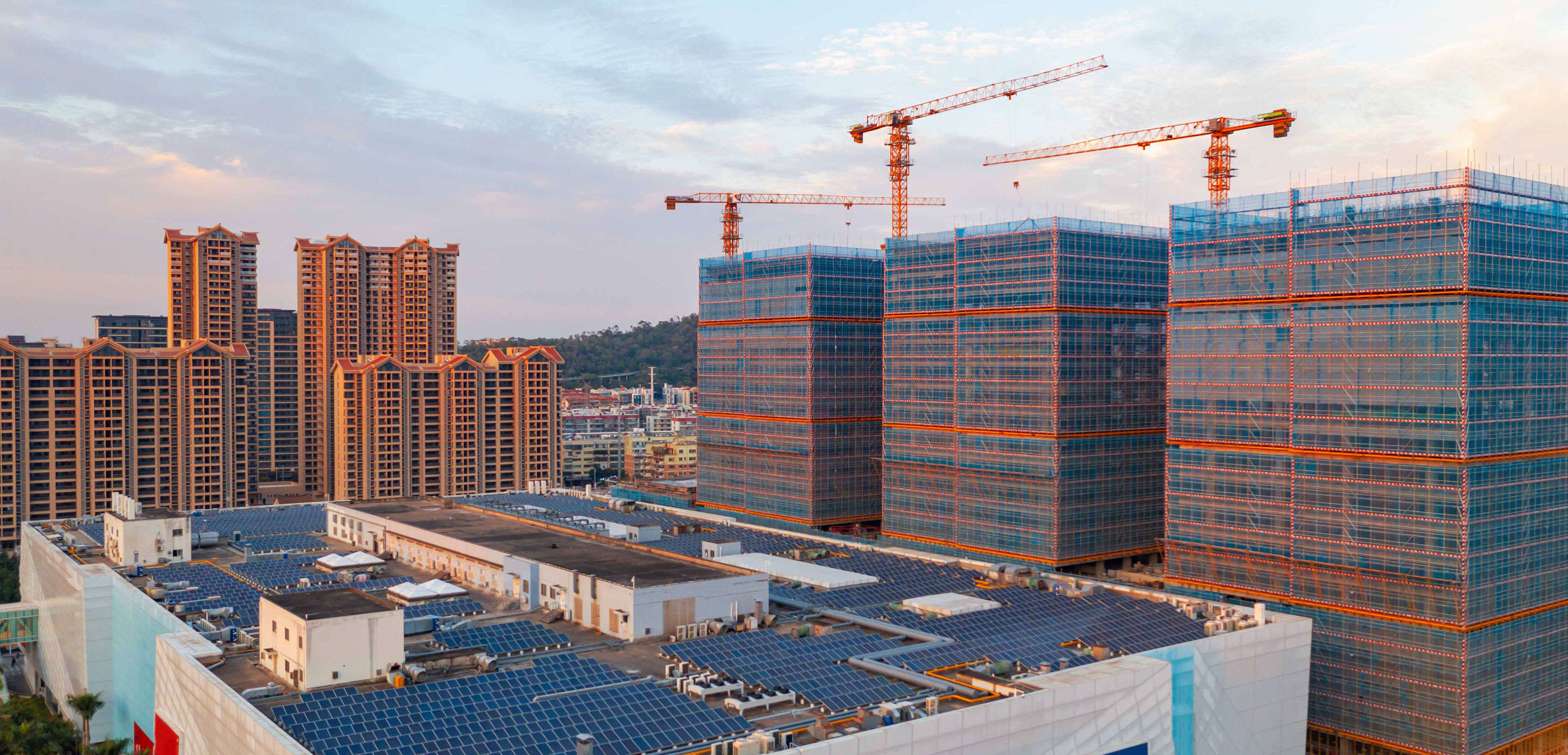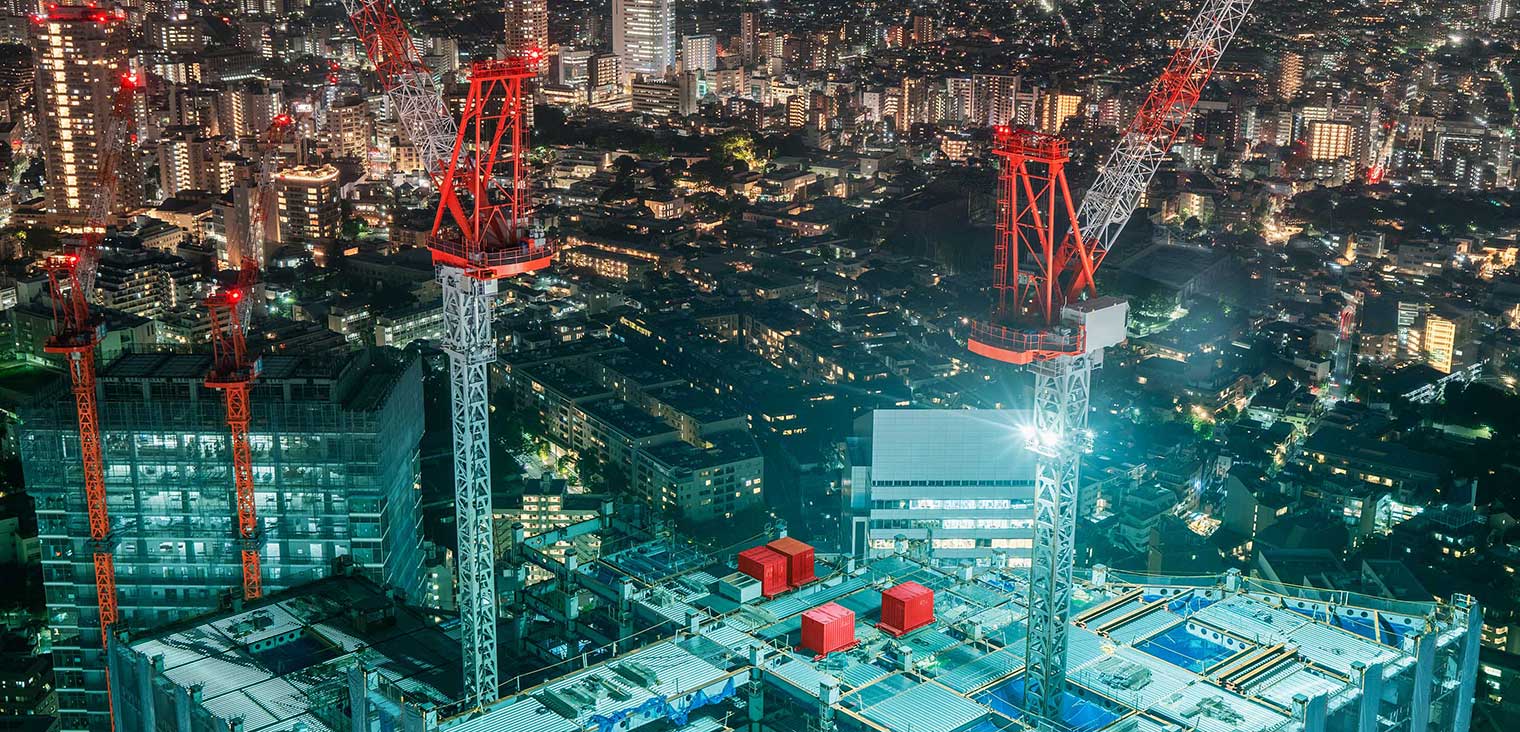- Article

- Infrastructure and Sustainable Finance
- Transition to Net Zero
- The Future of Infrastructure
- General Sustainability
Why embodied carbon is rising up the real estate agenda
A key challenge for the property industry is to reduce existing buildings’ operational emissions, but there is a growing focus on emissions from the construction of new real estate, or ‘embodied carbon’. Real estate developers and contractors are taking note.
For existing buildings the focus is on reducing the energy they consume and emissions they produce, and that is a growing challenge for the real estate industry as policymakers increasingly favour retrofitting over rebuilding. But for new properties, embodied emissions (those produced by construction materials) make up a material and growing proportion of their lifecycle emissions.
As a result, embodied carbon – which falls under scope 3, as it comes from the real estate sector’s supply chain – is increasingly coming into focus as policymakers and the property industry work towards long-term environmental targets.
Embodied carbon in materials like bricks, glass and steel is estimated to account for 11% of global greenhouse gas (GHG) emissions, with operational carbon making up 28%1. While that means the embodied carbon produces just over a quarter of all property-sector emissions, that proportion could potentially double to 50% by 2035, as operational emissions of buildings fall faster, thanks to rising operational energy efficiency.2
To be sure, reducing operational emissions will remain the key transition challenge for the property sector, bearing in mind that 80% of building stock in existence today will still be around in 2050.3 But embodied carbon deserves the greater attention it is getting, as a material issue for developers and investors.
After all, constructing buildings is a capital-intensive activity, and doing so to a tighter environmental standard comes at a higher price. That makes access to financing – whether from the public or private sector – a critical factor in the transition. Indeed, in HSBC’s recent survey of real estate businesses, financing, policy and legislation topped the list of factors influencing net zero strategies.
“Banks like HSBC are fully alert to the property sector’s growing sustainability needs – and the direction of policy travel in this area,” says Francis Yang, Managing Director, Real Estate Investment Banking at HSBC.
A new policy blueprint
Traditionally, policy in the EU4 and UK5, for instance, has focused on reducing GHG emissions associated with the energy needed to heat, cool and power a building rather than those associated with its materials and construction. After all, 80% of buildings that will be occupied in 2050 already exist, meaning decarbonising existing stock is a major priority.6
But something of a shift is under way. Some EU countries have moved to address both operational and embodied emissions. For instance, France introduced regulations in January 2022 to reduce emissions from construction materials over the life of the building, including demolition.7 Since the same date, developers in Sweden have had to calculate the embodied carbon of planned buildings before submitting them to the government to receive the final construction permit.8
In the UK, an industry group has proposed Part Z, an amendment to the UK Building Regulations 2010 that would ensure that the embodied carbon of all building projects will be assessed and capped as part of a comprehensive whole-life carbon assessment.9
Meanwhile, several increasingly widely adopted green building certifications, such as BREEAM and LEED, recognise the benefits of life cycle assessments. And it may be that embodied carbon is incorporated into how buildings are assessed under the EU and UK taxonomies of sustainable activities.10
Other regions, notably Asia and North America, are behind Europe on regulating property sector emissions, but there are moves to address the issue. For example, nine cities in the US and three in Asia Pacific and Canada, respectively, have signed the C40 Net Zero Carbon Buildings pledge.11 It is a commitment to adopt regulations and planning policies to ensure that new buildings are net-zero carbon by 2030 and all buildings by 2050.
Foundations for the future
The message is getting through. Nearly half (47%) of property developers globally see decarbonisation as fundamentally important to their business growth, finds HSBC’s Transition Pathways survey12.
“This growing focus on embodied carbon has implications for all parts of the real estate value chain. As developers look to lower-carbon materials and construction practices, suppliers and contractors will need to adapt,” says Sophie Lu, Global Head of Heavy Industry Decarbonisation, HSBC.
There are various actions they can take:
- Use low-carbon concrete mixes: Concrete is typically the biggest source of embodied carbon for a new site13, and lower-carbon versions are becoming more accessible as building codes and standards are updated. British construction firm Laing O'Rourke, for example, said it would switch to low-carbon concrete alternatives in all new UK projects starting after 1 April 2023.14
- Use less carbon-intensive materials or reuse materials: Aluminium, plastic and foam insulation, for instance, are often carbon-intensive. Brand new steel has an embodied carbon footprint five times that of recycled content steel.15 Hong Kong-based CaSO offers a ‘green block’ wall system as an environmentally friendly alternative to traditional concrete bricks.16 Meanwhile, UK-based Panthera Group, a construction site support company, switched from using single-use plywood for its hoarding – temporary fencing for building sites – to using more sustainable, reusable materials.
- Use fewer finishings: Developers can consider using structural materials to finish properties, such as polishing concrete slabs to encourage occupiers not to add carpet or vinyl to floors.
- Electrify construction sites: Using batteries to power heavy-duty machines like cranes or excavators is difficult because doing so takes a lot of energy, and improvements to charging infrastructure are needed.17 But some companies are moving early on this front. Select Plant Hire, part of Laing O’Rourke18, added its first electric crawler-crane in March 2021. And as companies like Hong Kong-based Ampd produce more industrial-scale batteries, contractors are able to replace diesel-powered generators on construction sites.19
- Look for innovative solutions: Modular construction, wooden frames, and even top-down building methods can all reduce the emissions generated in a major construction project. When retrofitting a former Shoreditch warehouse proved unviable, British workspace provider The Office Group replaced it with what is now central London’s tallest mass timber office structure, the six-storey Black & White Building, which was unveiled in 2023.20
Building value
Advances in building design and modern materials represent major opportunities for decarbonisation, but they also present obstacles for developers, perhaps the most substantial being higher upfront costs. In the long term, however, the outlay may be worthwhile, as investors and occupiers pay more for green buildings.21
For example, low-carbon concrete is more expensive to produce than traditional concrete, so can be difficult for contractors to incorporate into their construction projects, especially when budgets are tight and bearing in mind it is a relatively new technology.22 But using it to reduce a building’s carbon footprint can offset some of this extra cost by making the property asset itself more valuable.
Similarly, electric construction vehicles can cost as much as triple their diesel counterparts, by some estimates.23 Yet this may soon change as battery prices continue to fall and demand increases.
Ultimately, lenders and investors are increasingly taking embodied carbon into account as they analyse the emissions profile of their own portfolios.
“Greener buildings already command a premium from investors and occupiers, and this trend will only gather pace,” says Andrew McDonald, Managing Director, Real Estate Finance at HSBC UK. “Construction processes and embodied carbon are key to understanding the whole-life impact of any building, and we can expect this growing awareness to reshape the entire value chain over the coming decades.”
Property developers and service providers that recognise this new reality will ensure they are left with the most valuable and long-term sustainable assets – while simultaneously helping the industry transition to net zero.
Today we finance a number of industries that significantly contribute to greenhouse gas emissions. We have a strategy to help our customers to reduce their emissions and to reduce our own. Find out more: https://www.hsbc.com/who-we-are/our-climate-strategy
For HSBC’s Transition Pathways survey, HSBC has worked with Kantar, a data, insights and consulting company. The survey is not wholly-representative of HSBC’s customer base and covers respondents across 321 key financial decision makers from businesses operating in the Real Estate sector, comprising Developers (163) and Investors (158) and operated across Residential and Office, Retail and Hospitality and Logistics and Data Centres. Businesses were located in Europe (61, of which 35 were in the UK), Asia (97, of which 43 were in Hong Kong), the Middle East (31) and North/Central America (132). Overall 146 (45%) had a gross asset value below $1.5bn, 67 (21%) had a gross asset value between $1.5bn and $4.9bn and 108 (34%) had a gross asset value in excess of $5bn. 99 (31%) had been established for less than 10 years and 222 (69%) for more than 10 years. Data was collected through an online questionnaire and the survey ran from 5 to 17 July 2023.
In preparing this survey, HSBC has relied upon available data, information and responses given at the time of writing. This report should not form the basis of any third party’s decision to undertake, or otherwise engage in, any activity and third parties do not have any right to rely on it. Neither HSBC nor Kantar accept any duty of care, responsibility or liability in relation to this research or its application or interpretation, including as to the accuracy, completeness or sufficiency of it or any outcomes arising from the same.
1 World Green Building Council: Bringing embodied carbon upfront
2 Net Zero Whole Life Carbon Roadmap: A pathway to net zero for the UK built environment
3 Climate Group: Energy efficiency measures will lead the way to net zero buildings
4 Deepki: How to address the challenges of embodied carbon in 2023
5 UK Parliament: Building to net zero costing carbon in construction
6 UK GBC: Climate change mitigation
7 Réglementation environnementale RE2020
8 GRESB: Embodied carbon what it is and how to tackle it
9 Proposed Document Z – our proof of concept for implementing embodied carbon regulation
10 CBRE: Embodied carbon: the next big climate challenge for real estate
11 C40 Cities: Net Zero Carbon Buildings Accelerator
12 HSBC: Transition Pathways: Real Estate
13 Carbon Cure: A Complete Guide to Low Carbon Concrete
14 Architects' Journal: Laing O’Rourke switches to low-carbon concrete on all new UK projects
15 GRESB: Embodied carbon what it is and how to tackle it
16 HSBC: Constructing a greener future – CaSO (HK) Engineering Company
17 GreenBiz: What it will take to electrify construction equipment
18 HSBC: How do you reduce noise pollution with a 250 tonne crane?
19 HSBC: Inspiration from our clients
20 Architects' Journal: Timber all the way: The Black & White Building by Waugh Thistleton
21 JLL: Environmentally sustainable real estate attracts higher prices
22 ICE: Low Carbon Concrete Routemap
23 Equipment World: Future Fuels Pt. 1: The End of Diesel's Dominance?
Transition Pathways
Explore more of the findings and insights on the real estate sector.



